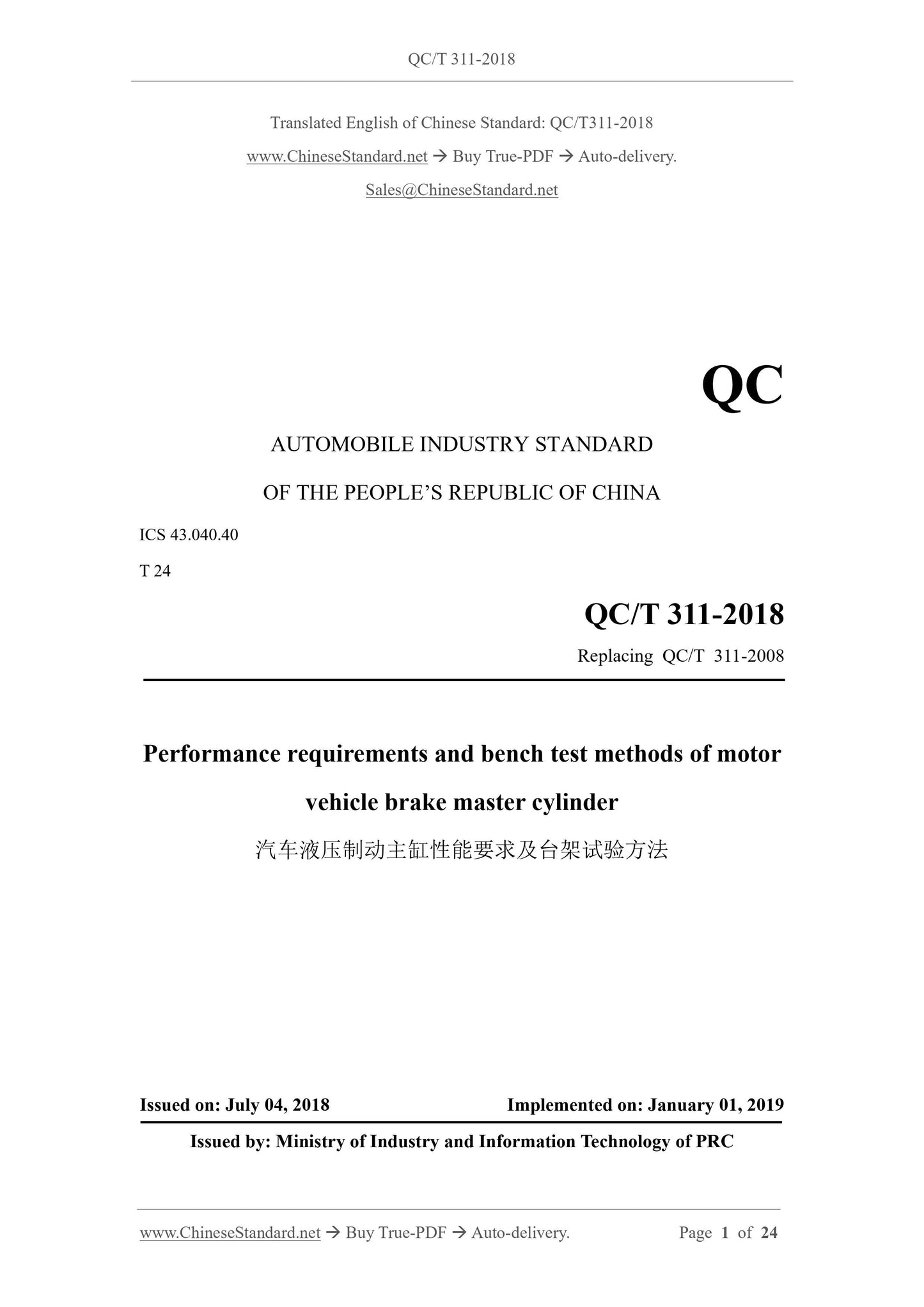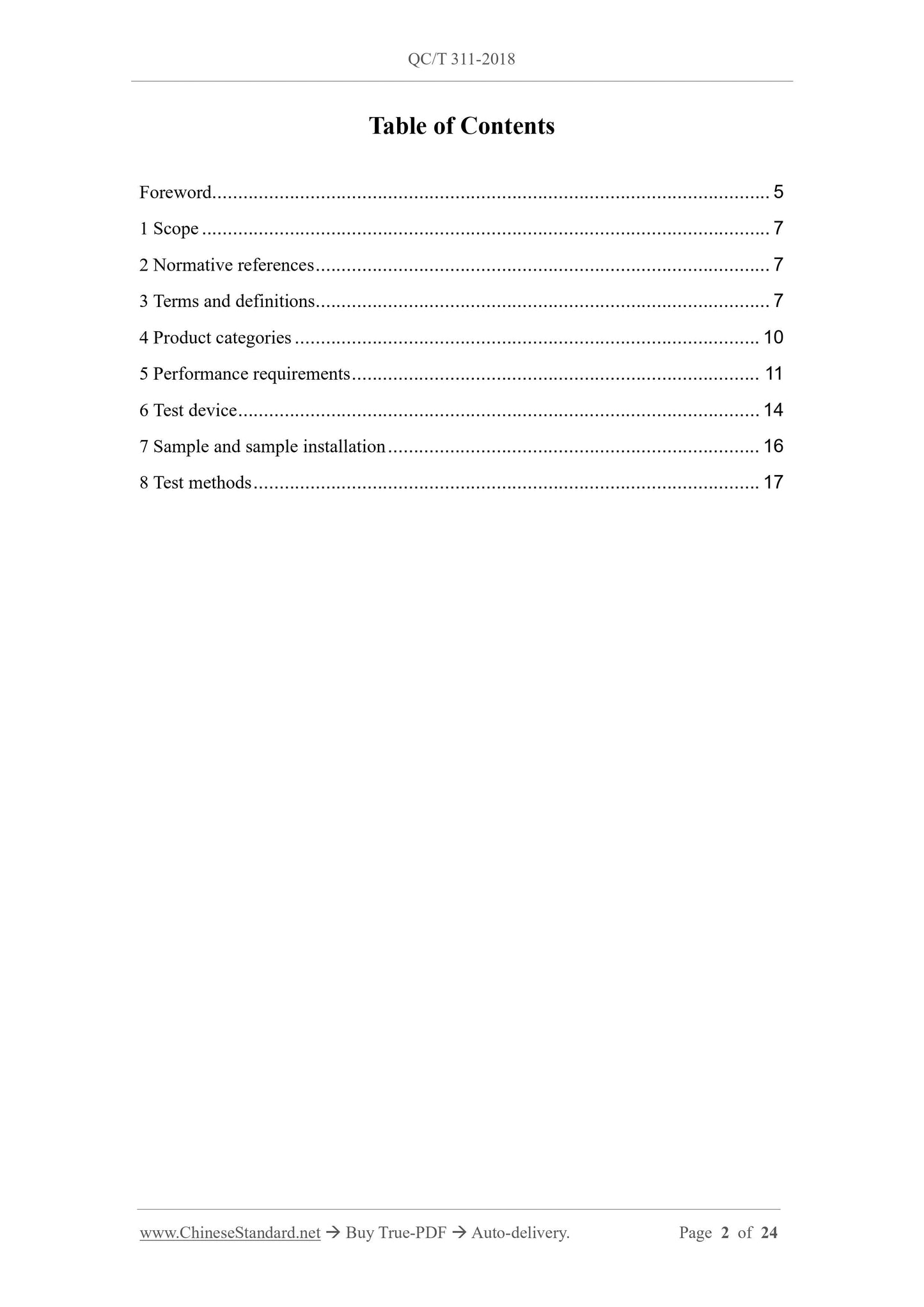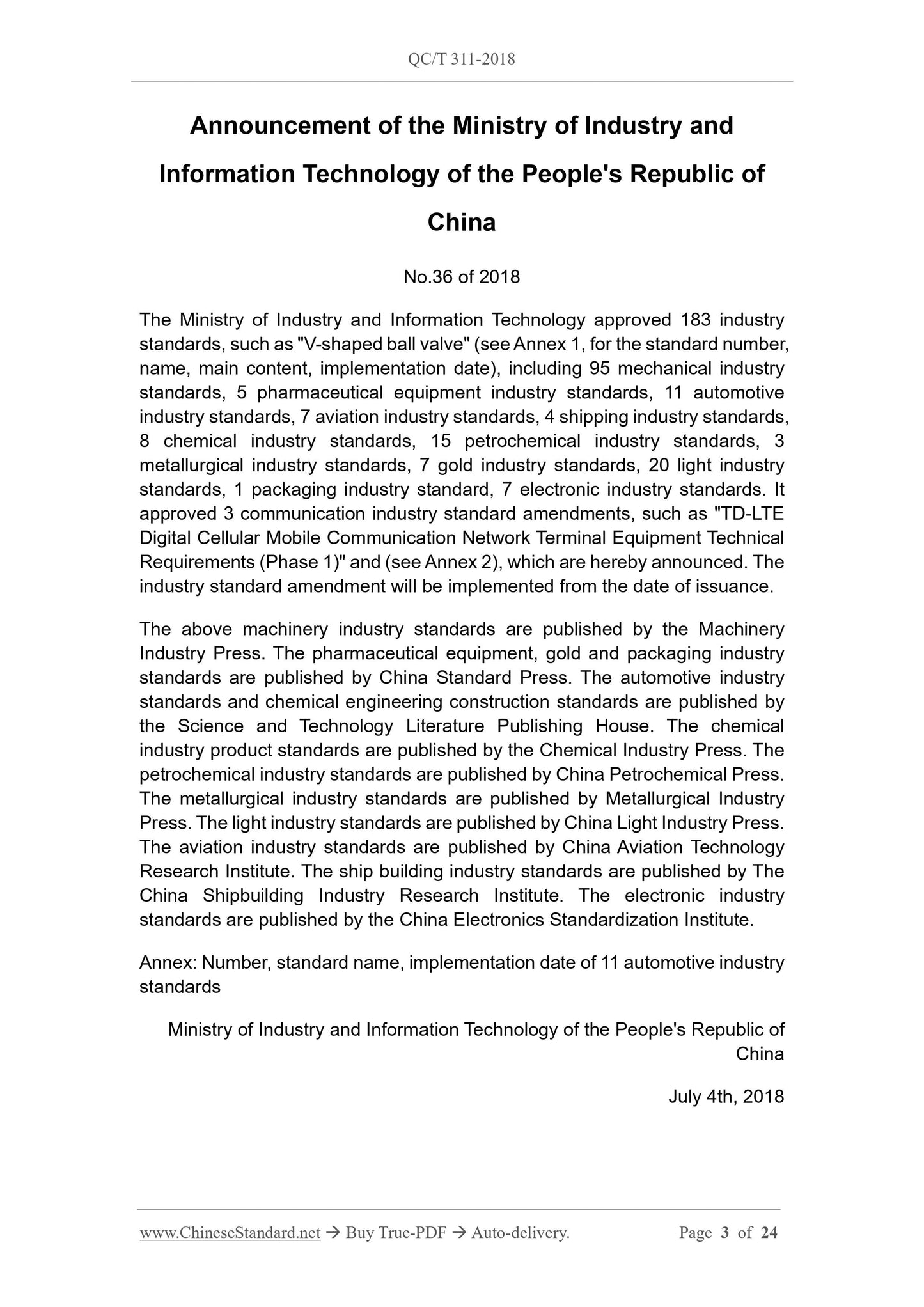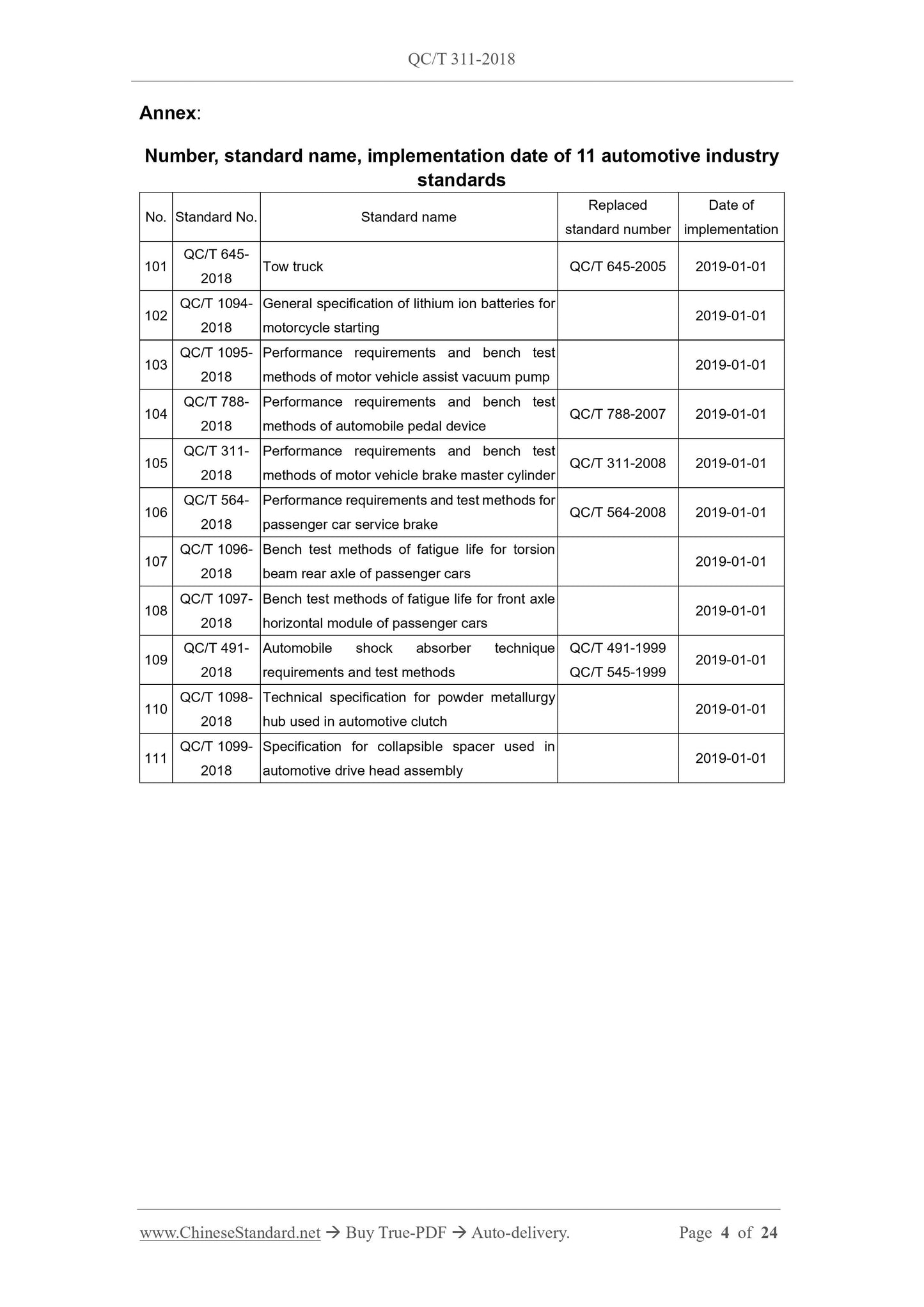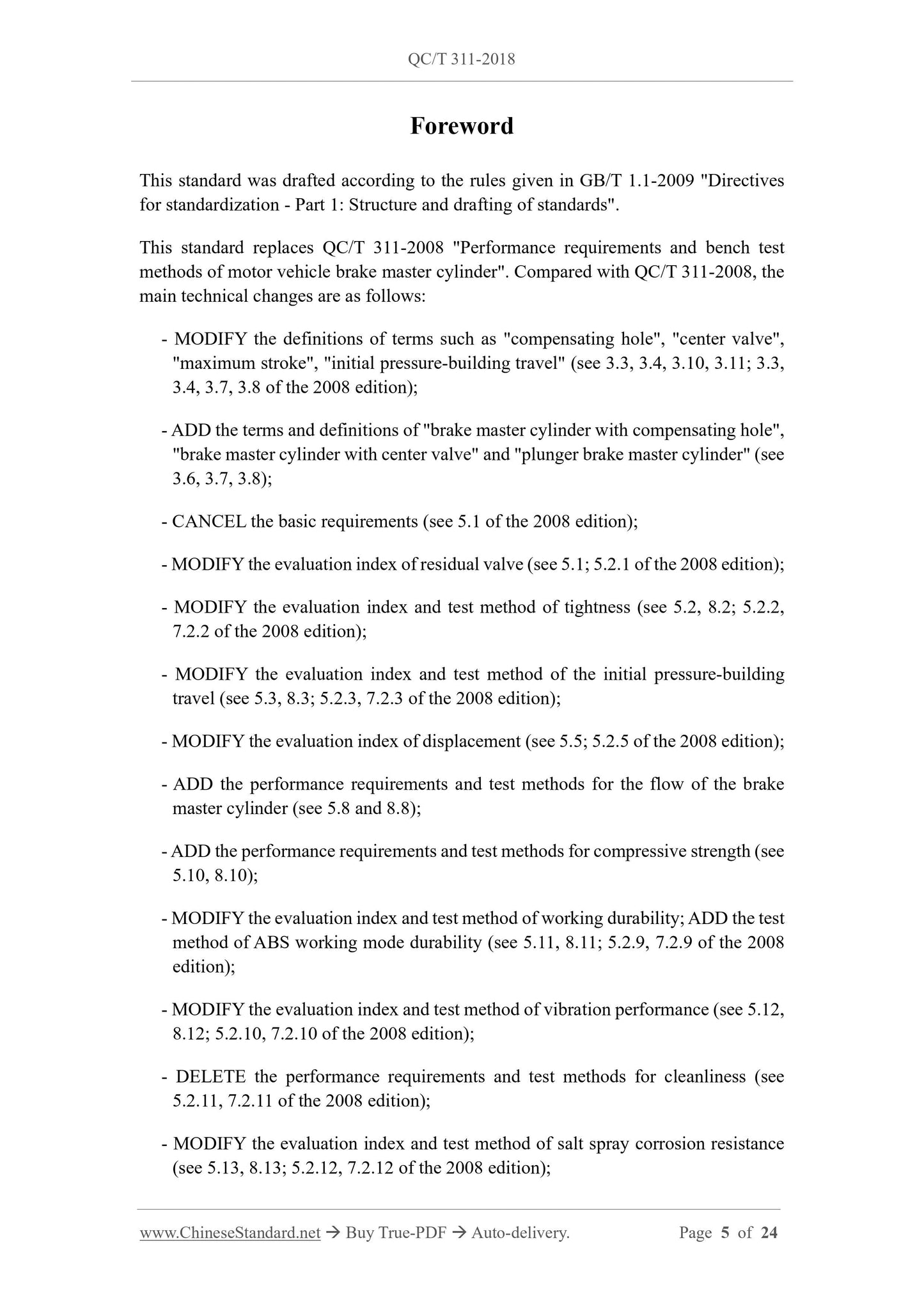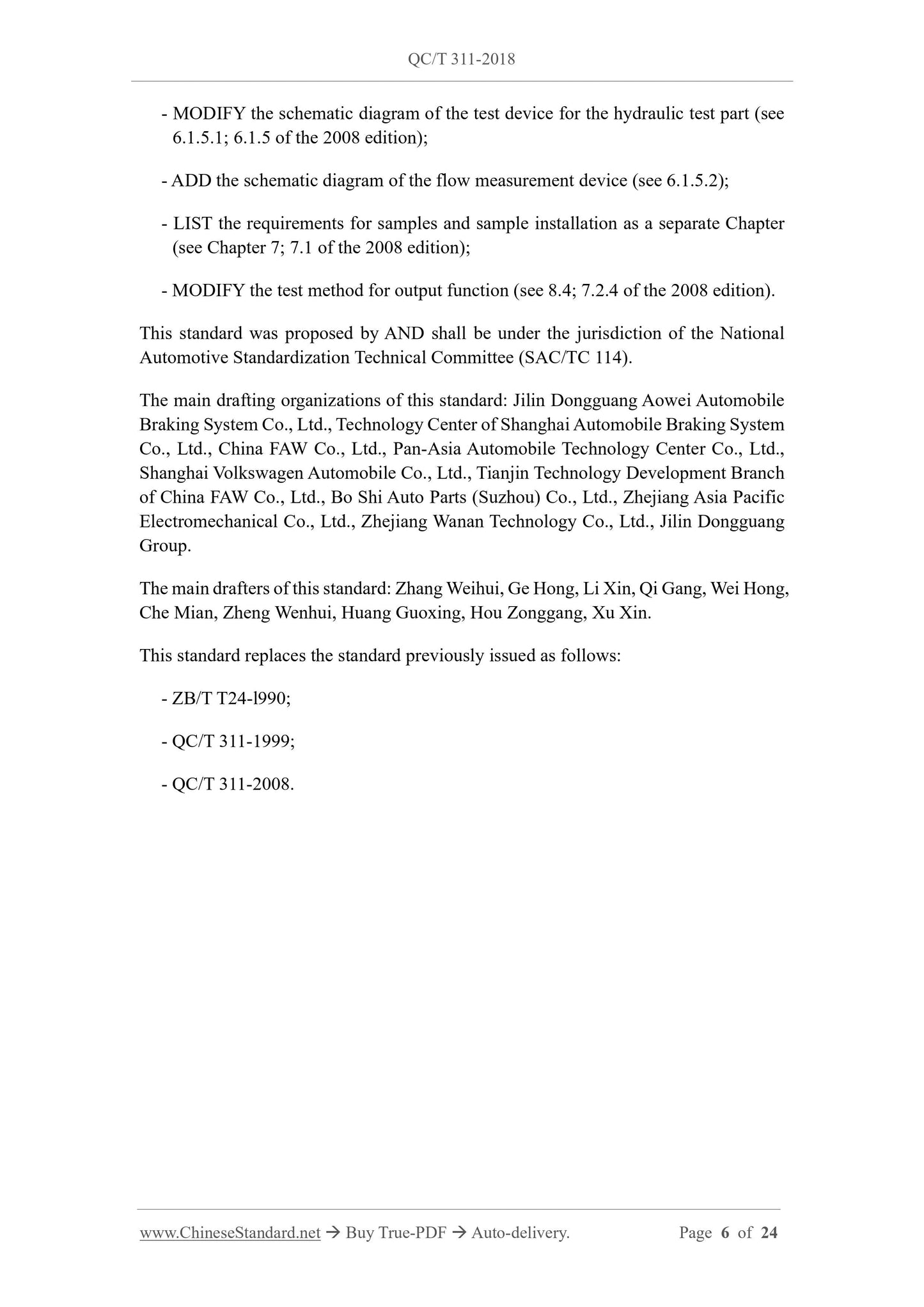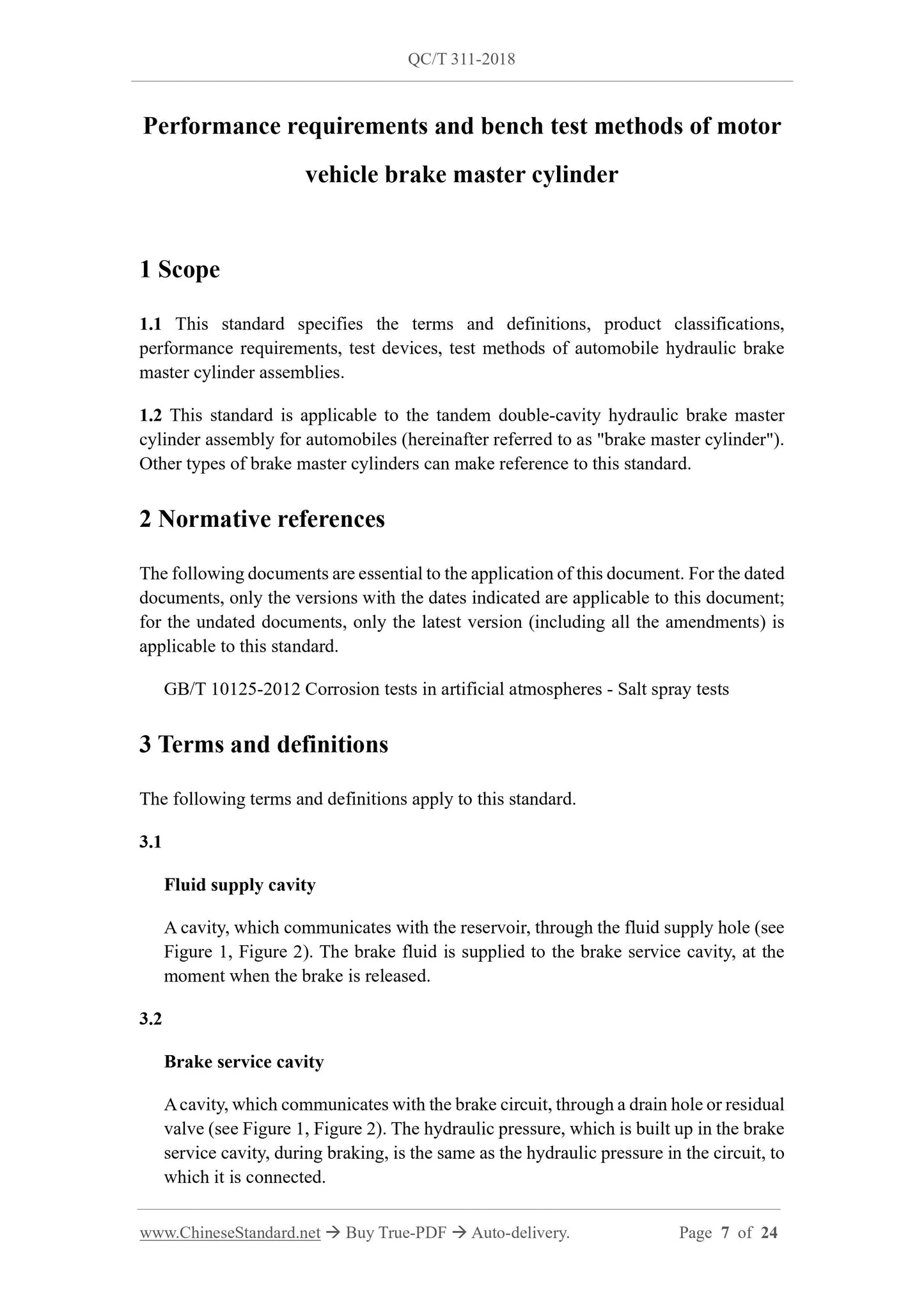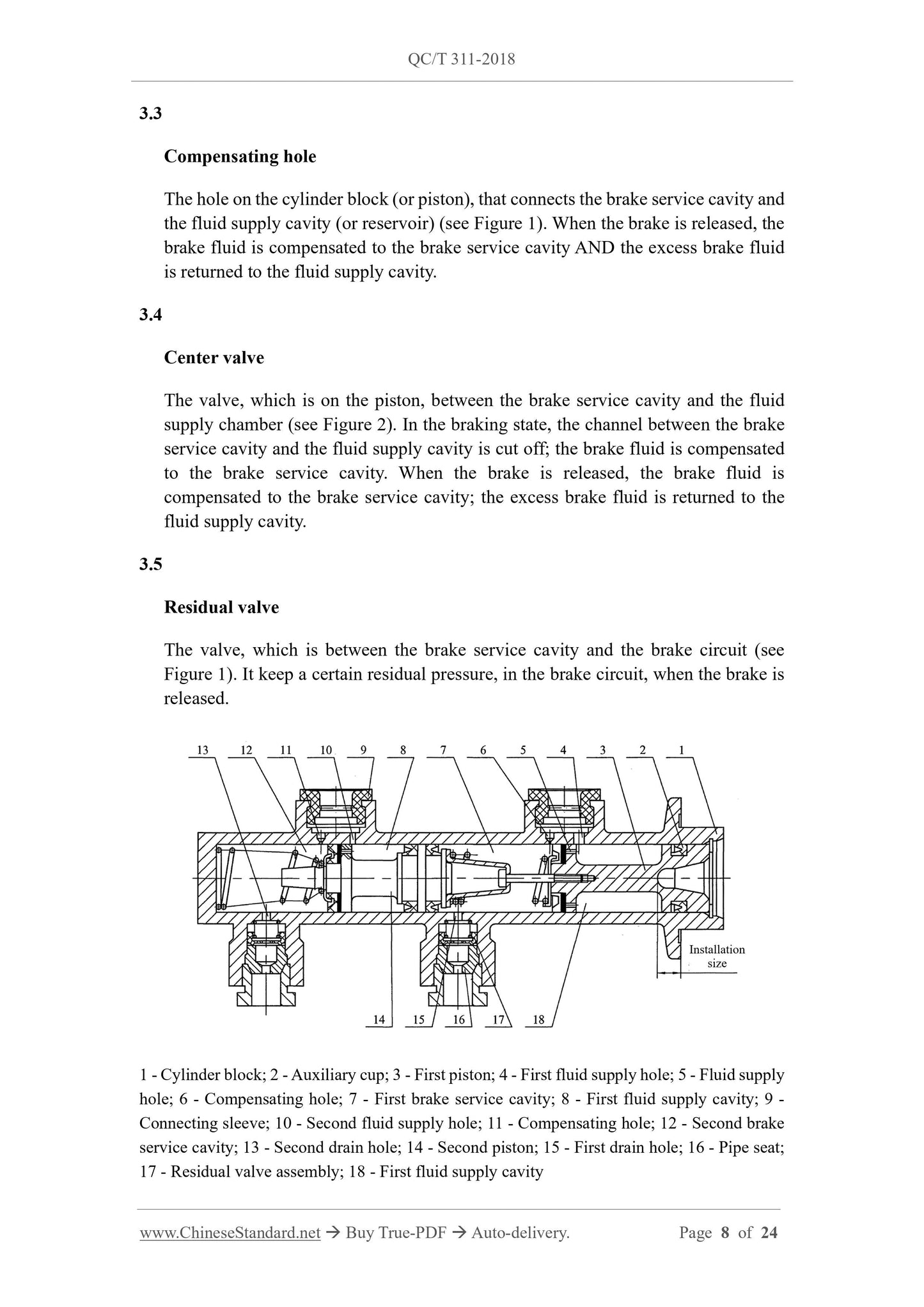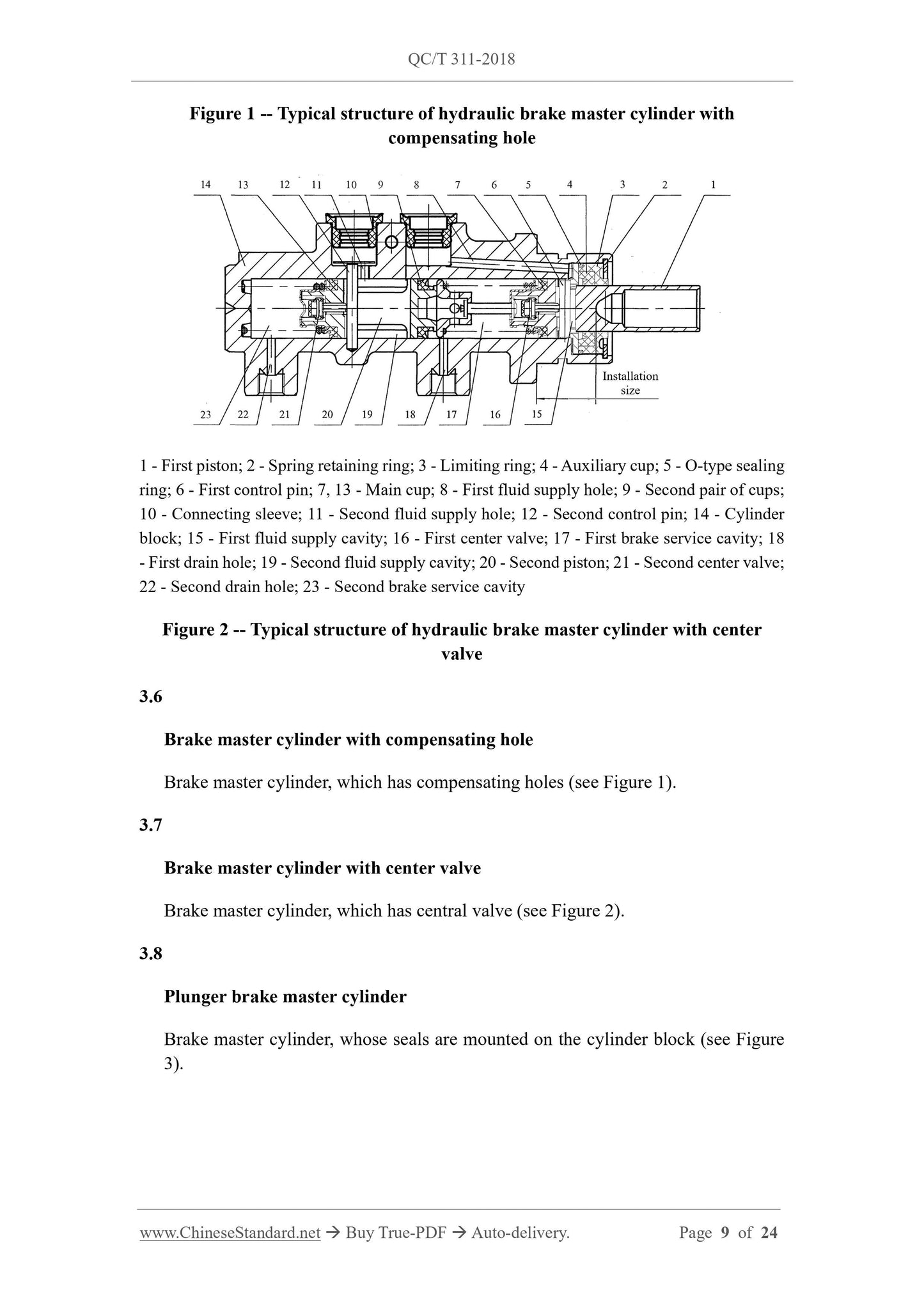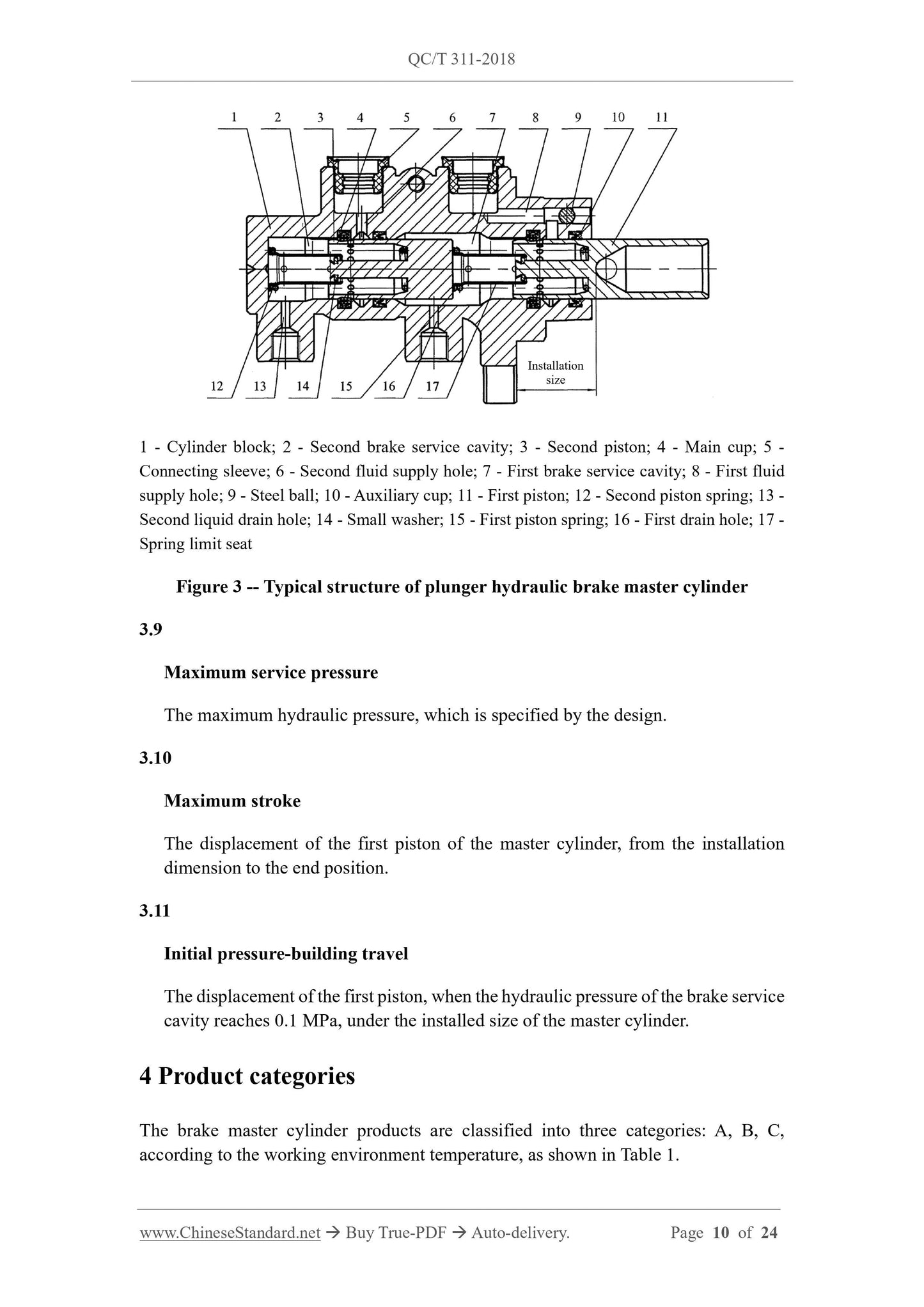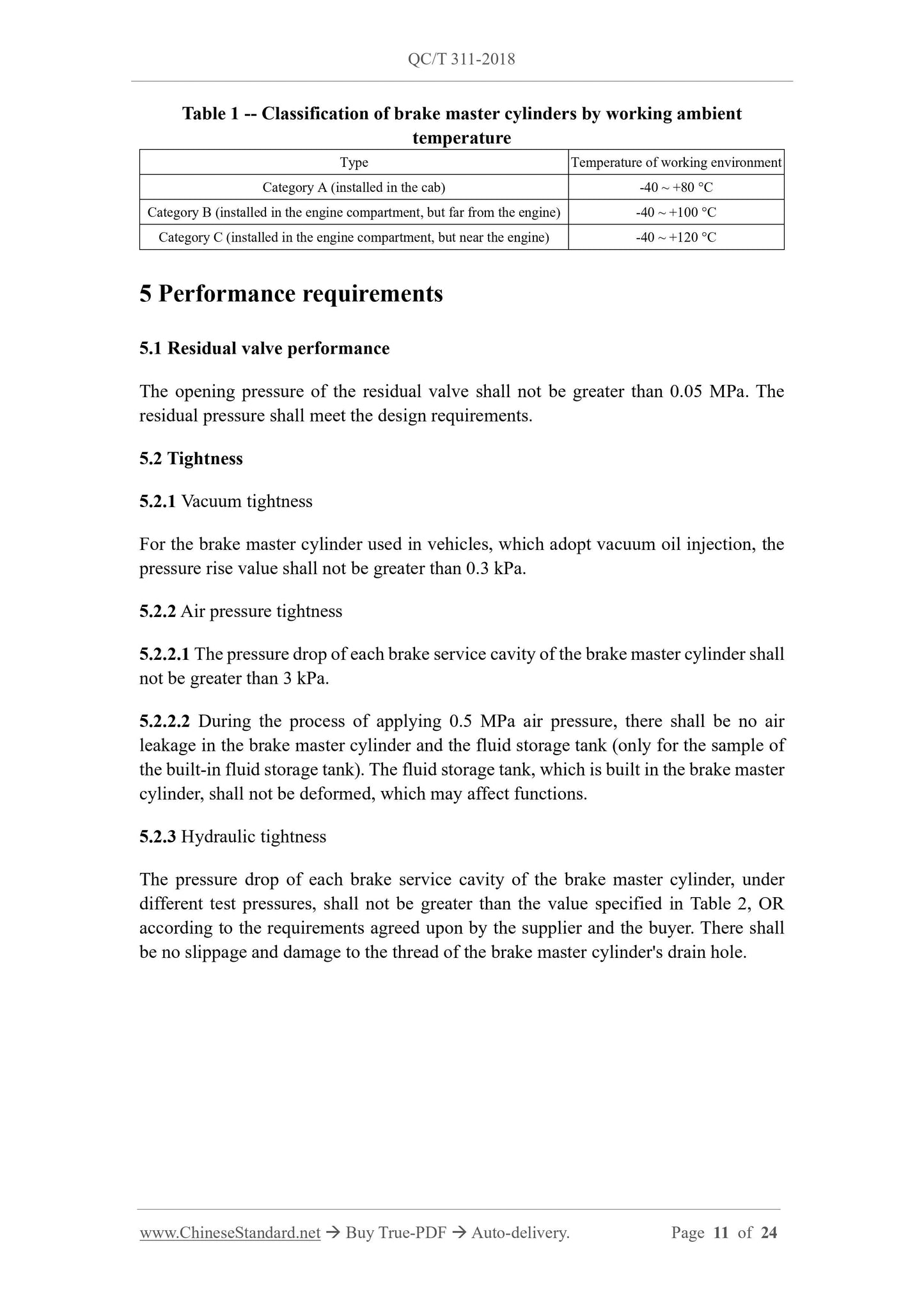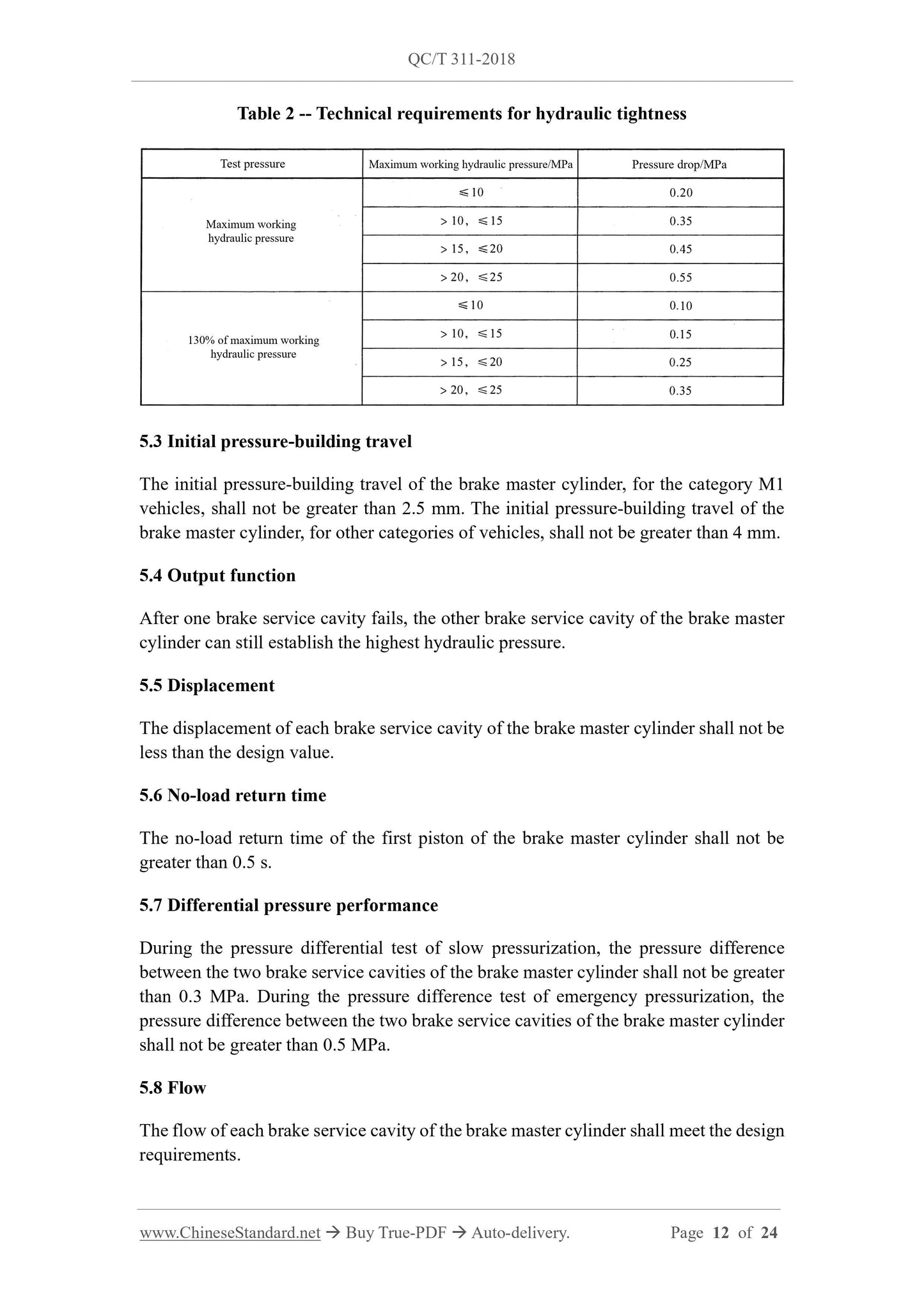1
/
trong số
12
PayPal, credit cards. Download editable-PDF & invoice in 1 second!
QC/T 311-2018 English PDF (QCT311-2018)
QC/T 311-2018 English PDF (QCT311-2018)
Giá thông thường
$225.00 USD
Giá thông thường
Giá ưu đãi
$225.00 USD
Đơn giá
/
trên
Phí vận chuyển được tính khi thanh toán.
Không thể tải khả năng nhận hàng tại cửa hàng
Delivery: 3 seconds. Download true-PDF + Invoice.
Get QUOTATION in 1-minute: Click QC/T 311-2018
Historical versions: QC/T 311-2018
Preview True-PDF (Reload/Scroll if blank)
QC/T 311-2018: Performance requirements and bench test methods of motor vehicle brake master cylinder
QC/T 311-2018
AUTOMOBILE INDUSTRY STANDARD
OF THE PEOPLE’S REPUBLIC OF CHINA
ICS 43.040.40
T 24
Replacing QC/T 311-2008
Performance requirements and bench test methods of motor
vehicle brake master cylinder
ISSUED ON: JULY 04, 2018
IMPLEMENTED ON: JANUARY 01, 2019
Issued by: Ministry of Industry and Information Technology of PRC
Table of Contents
Foreword ... 5
1 Scope ... 7
2 Normative references ... 7
3 Terms and definitions... 7
4 Product categories ... 10
5 Performance requirements ... 11
6 Test device ... 14
7 Sample and sample installation ... 16
8 Test methods ... 17
Performance requirements and bench test methods of motor
vehicle brake master cylinder
1 Scope
1.1 This standard specifies the terms and definitions, product classifications,
performance requirements, test devices, test methods of automobile hydraulic brake
master cylinder assemblies.
1.2 This standard is applicable to the tandem double-cavity hydraulic brake master
cylinder assembly for automobiles (hereinafter referred to as "brake master cylinder").
Other types of brake master cylinders can make reference to this standard.
2 Normative references
The following documents are essential to the application of this document. For the dated
documents, only the versions with the dates indicated are applicable to this document;
for the undated documents, only the latest version (including all the amendments) is
applicable to this standard.
GB/T 10125-2012 Corrosion tests in artificial atmospheres - Salt spray tests
3 Terms and definitions
The following terms and definitions apply to this standard.
3.1
Fluid supply cavity
A cavity, which communicates with the reservoir, through the fluid supply hole (see
Figure 1, Figure 2). The brake fluid is supplied to the brake service cavity, at the
moment when the brake is released.
3.2
Brake service cavity
A cavity, which communicates with the brake circuit, through a drain hole or residual
valve (see Figure 1, Figure 2). The hydraulic pressure, which is built up in the brake
service cavity, during braking, is the same as the hydraulic pressure in the circuit, to
which it is connected.
5.9 Pressure shock
After the pressure shock test, the brake master cylinder shall be free from deformation
and damage, which affect the function. When the test pressure is the maximum working
hydraulic pressure of the brake master cylinder, the tightness shall meet the
requirements of Table 2. If the brake master cylinder has its own storage tank, after the
pressure shock test, no brake fluid shall escape from the reservoir.
5.10 Compressive strength
After the pressure test, the brake master cylinder shall be free from abnormal
phenomena, such as deformation and leakage; its hydraulic tightness shall meet the
requirements of 5.2.3.
5.11 Working durability
During the test, there shall be no leakage or any abnormality in the brake master
cylinder; the piston shall be flexible. After the test, the hydraulic tightness shall meet
the requirements of 5.2.3. If it is equipped with the reservoir, then during the working
durability test, there shall be no brake fluid overflowing from the reservoir. After the
test, the connection between the reservoir and the brake master cylinder shall not be
loose.
5.12 Vibration performance
5.12.1 During the vibration performance test, there shall be no brake fluid overflowing
from the reservoir. After the test, the connection between the reservoir and the brake
master cylinder shall not be loose. There shall be no deformation or damage, which may
affect the function.
5.12.2 Compared with before the test, the residual tightening torque shall be greater
than 50%.
5.13 Salt spray corrosion resistance
After the salt spray corrosion resistance test, the brake master cylinder shall meet the
requirements of Table 3.
6 Test device
6.1 Test device of brake master cylinder
6.1.1 Drive
The push rod head of the drive device shall be consistent with the size and specification
of the push rod head of the real vehicle sample. The initial included angle, between the
push rod and the axis of the brake master cylinder, shall not be greater than 2°. The
drive device can push the piston of the sample once and periodically. The piston of the
sample can move to the maximum stroke position. The pushing distance can be adjusted
and can be fixed at any position. The rate of sample's pressure-building, during pushing,
can be adjusted. When the piston of the sample is pushed once, the maximum working
hydraulic pressure of the sample, 130% of the maximum working hydraulic pressure,
can be established, in the brake service cavity of the sample, which can ensure that the
piston of the sample can return quickly, without other restrictions in different pushing
positions. When pushing the piston of the sample periodically, the pushing frequency,
pressure increasing time, pressure holding time, pressure reducing time, pause time, etc.
can be adjusted.
6.1.2 Load device
The load device can simulate the working state of the hydraulic brake wheel cylinder
in the brake. The relationship, between the loading pressure and the sample stroke, can
be adjusted as required. The movable parts in the load device can be locked as required.
6.1.3 Measuring device
6.1.3.1 The effective measurement values of instruments or meters, which are used to
measure pressure, shift, displacement, flow, moment, length, shall be greater than the
values to be measured. The relative error of measurement shall not exceed ±1%.
However, it may use the level 1.5 pressure gauge, to monitor the pressure value of the
working durability test.
6.1.3.2 The relative error of the time measuring instrument, to measure the return time
of the sample without load, shall not exceed ±5%.
6.1.3.3 When measuring the initial pressure-building travel, output function, no-load
return time, hydraulic tightness, differential pressure performance, the total effective
volume of the test circuit is 135 ~ 150 mL.
8.1.2 Connect the drain hole of the sample to the gas source. Gradually introduce gas,
which has a pressure of not more than 0.15 MPa, into the drain hole. Record the lowest
gas pressure, which is input to the drain hole, when gas flows out of the compensating
hole (residual pressure of residual valve).
8.2 Tightness
8.2.1 Vacuum tightness
8.2.1.1 Close the sample's liquid drain hole. Connect the two fluid supply holes, to the
vacuum source (if the sample comes with a reservoir, the vacuum source is directly
connected to the liquid filling port of the reservoir).
8.2.1.2 Vacuum the system to the absolute pressure (250 ± 50) Pa (or the pressure agreed
by the supplier and the buyer). Then cut off the vacuum source. Immediately record the
pressure rise value in the test system, within 5 s after that.
8.2.2 Air tightness
8.2.2.1 Connect the sample and drive to the test circuit.
8.2.2.2 Use the push rod of the drive device, to push the piston of the sample beyond
the initial pressure-building travel of the sample.
8.2.2.3 Connect the drain hole of the sample to the gas source. Adjust the gas source
pressure to (50 ± 2) kPa. Then cut off the gas source.
8.2.2.4 After stabilizing for 3 ~ 5 s, measure the pressure drop of each brake service
cavity of the sample, within 10 s after that.
8.2.2.5 The push rod of the drive device returns to its original position.
8.2.2.6 Block the liquid drain ho...
Get QUOTATION in 1-minute: Click QC/T 311-2018
Historical versions: QC/T 311-2018
Preview True-PDF (Reload/Scroll if blank)
QC/T 311-2018: Performance requirements and bench test methods of motor vehicle brake master cylinder
QC/T 311-2018
AUTOMOBILE INDUSTRY STANDARD
OF THE PEOPLE’S REPUBLIC OF CHINA
ICS 43.040.40
T 24
Replacing QC/T 311-2008
Performance requirements and bench test methods of motor
vehicle brake master cylinder
ISSUED ON: JULY 04, 2018
IMPLEMENTED ON: JANUARY 01, 2019
Issued by: Ministry of Industry and Information Technology of PRC
Table of Contents
Foreword ... 5
1 Scope ... 7
2 Normative references ... 7
3 Terms and definitions... 7
4 Product categories ... 10
5 Performance requirements ... 11
6 Test device ... 14
7 Sample and sample installation ... 16
8 Test methods ... 17
Performance requirements and bench test methods of motor
vehicle brake master cylinder
1 Scope
1.1 This standard specifies the terms and definitions, product classifications,
performance requirements, test devices, test methods of automobile hydraulic brake
master cylinder assemblies.
1.2 This standard is applicable to the tandem double-cavity hydraulic brake master
cylinder assembly for automobiles (hereinafter referred to as "brake master cylinder").
Other types of brake master cylinders can make reference to this standard.
2 Normative references
The following documents are essential to the application of this document. For the dated
documents, only the versions with the dates indicated are applicable to this document;
for the undated documents, only the latest version (including all the amendments) is
applicable to this standard.
GB/T 10125-2012 Corrosion tests in artificial atmospheres - Salt spray tests
3 Terms and definitions
The following terms and definitions apply to this standard.
3.1
Fluid supply cavity
A cavity, which communicates with the reservoir, through the fluid supply hole (see
Figure 1, Figure 2). The brake fluid is supplied to the brake service cavity, at the
moment when the brake is released.
3.2
Brake service cavity
A cavity, which communicates with the brake circuit, through a drain hole or residual
valve (see Figure 1, Figure 2). The hydraulic pressure, which is built up in the brake
service cavity, during braking, is the same as the hydraulic pressure in the circuit, to
which it is connected.
5.9 Pressure shock
After the pressure shock test, the brake master cylinder shall be free from deformation
and damage, which affect the function. When the test pressure is the maximum working
hydraulic pressure of the brake master cylinder, the tightness shall meet the
requirements of Table 2. If the brake master cylinder has its own storage tank, after the
pressure shock test, no brake fluid shall escape from the reservoir.
5.10 Compressive strength
After the pressure test, the brake master cylinder shall be free from abnormal
phenomena, such as deformation and leakage; its hydraulic tightness shall meet the
requirements of 5.2.3.
5.11 Working durability
During the test, there shall be no leakage or any abnormality in the brake master
cylinder; the piston shall be flexible. After the test, the hydraulic tightness shall meet
the requirements of 5.2.3. If it is equipped with the reservoir, then during the working
durability test, there shall be no brake fluid overflowing from the reservoir. After the
test, the connection between the reservoir and the brake master cylinder shall not be
loose.
5.12 Vibration performance
5.12.1 During the vibration performance test, there shall be no brake fluid overflowing
from the reservoir. After the test, the connection between the reservoir and the brake
master cylinder shall not be loose. There shall be no deformation or damage, which may
affect the function.
5.12.2 Compared with before the test, the residual tightening torque shall be greater
than 50%.
5.13 Salt spray corrosion resistance
After the salt spray corrosion resistance test, the brake master cylinder shall meet the
requirements of Table 3.
6 Test device
6.1 Test device of brake master cylinder
6.1.1 Drive
The push rod head of the drive device shall be consistent with the size and specification
of the push rod head of the real vehicle sample. The initial included angle, between the
push rod and the axis of the brake master cylinder, shall not be greater than 2°. The
drive device can push the piston of the sample once and periodically. The piston of the
sample can move to the maximum stroke position. The pushing distance can be adjusted
and can be fixed at any position. The rate of sample's pressure-building, during pushing,
can be adjusted. When the piston of the sample is pushed once, the maximum working
hydraulic pressure of the sample, 130% of the maximum working hydraulic pressure,
can be established, in the brake service cavity of the sample, which can ensure that the
piston of the sample can return quickly, without other restrictions in different pushing
positions. When pushing the piston of the sample periodically, the pushing frequency,
pressure increasing time, pressure holding time, pressure reducing time, pause time, etc.
can be adjusted.
6.1.2 Load device
The load device can simulate the working state of the hydraulic brake wheel cylinder
in the brake. The relationship, between the loading pressure and the sample stroke, can
be adjusted as required. The movable parts in the load device can be locked as required.
6.1.3 Measuring device
6.1.3.1 The effective measurement values of instruments or meters, which are used to
measure pressure, shift, displacement, flow, moment, length, shall be greater than the
values to be measured. The relative error of measurement shall not exceed ±1%.
However, it may use the level 1.5 pressure gauge, to monitor the pressure value of the
working durability test.
6.1.3.2 The relative error of the time measuring instrument, to measure the return time
of the sample without load, shall not exceed ±5%.
6.1.3.3 When measuring the initial pressure-building travel, output function, no-load
return time, hydraulic tightness, differential pressure performance, the total effective
volume of the test circuit is 135 ~ 150 mL.
8.1.2 Connect the drain hole of the sample to the gas source. Gradually introduce gas,
which has a pressure of not more than 0.15 MPa, into the drain hole. Record the lowest
gas pressure, which is input to the drain hole, when gas flows out of the compensating
hole (residual pressure of residual valve).
8.2 Tightness
8.2.1 Vacuum tightness
8.2.1.1 Close the sample's liquid drain hole. Connect the two fluid supply holes, to the
vacuum source (if the sample comes with a reservoir, the vacuum source is directly
connected to the liquid filling port of the reservoir).
8.2.1.2 Vacuum the system to the absolute pressure (250 ± 50) Pa (or the pressure agreed
by the supplier and the buyer). Then cut off the vacuum source. Immediately record the
pressure rise value in the test system, within 5 s after that.
8.2.2 Air tightness
8.2.2.1 Connect the sample and drive to the test circuit.
8.2.2.2 Use the push rod of the drive device, to push the piston of the sample beyond
the initial pressure-building travel of the sample.
8.2.2.3 Connect the drain hole of the sample to the gas source. Adjust the gas source
pressure to (50 ± 2) kPa. Then cut off the gas source.
8.2.2.4 After stabilizing for 3 ~ 5 s, measure the pressure drop of each brake service
cavity of the sample, within 10 s after that.
8.2.2.5 The push rod of the drive device returns to its original position.
8.2.2.6 Block the liquid drain ho...
Share
